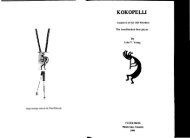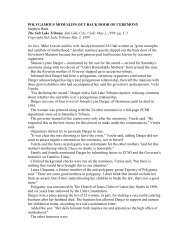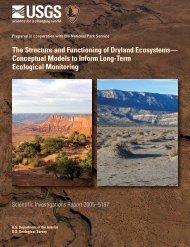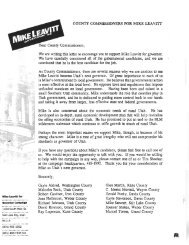View Document - Southern Utah University
View Document - Southern Utah University
View Document - Southern Utah University
You also want an ePaper? Increase the reach of your titles
YUMPU automatically turns print PDFs into web optimized ePapers that Google loves.
Katie Kent ’05 filming Thea Hinkle ’05 at work on location in<br />
<strong>Utah</strong> for “Jurassic High: Fossil Detectives at Webb” DVD<br />
Hadrosaurs and Helicopters<br />
(continued from page 1)<br />
Duncan Everhart, one of our volunteers,<br />
announced that he had found something<br />
big on the side of a steep canyon. The<br />
next day he took us to the site. It was<br />
impressive, as scattered down the side<br />
of the canyon lay two hundred bone<br />
fragments. At the top of this fragment<br />
trail, was a three-foot-long mass of<br />
bone protruding from rock. Field<br />
identifications are notoriously incorrect<br />
as one can only see some of<br />
the bones and they are often<br />
exposed at odd angles due<br />
to erosion. But based on<br />
size and the way the bone<br />
was concentrated in a single<br />
mass, we guessed it was<br />
either the pelvis or skull of a<br />
large dinosaur. Because the<br />
trip was ending the next day,<br />
we decided not to excavate. We collected<br />
the eroded bone fragments, covered the<br />
bone mass with plastic bags and loose rock<br />
to protect it from the elements and left,<br />
planning to return in 2003.<br />
People often ask me, “Won’t someone<br />
find the specimen and collect it first?”<br />
The answer is no. We usually work in<br />
very remote areas where few people<br />
wander. In fact, we nearly didn’t work<br />
in this area either. The Summer Peccary<br />
Trip had been going out to Montana to<br />
collect dinosaurs and other vertebrates<br />
for most of the 1990’s, but by 1998,<br />
our Montana research project started to<br />
Based on size and<br />
the way the bone was<br />
concentrated in a single<br />
mass, we guessed it was<br />
either the pelvis or skull<br />
of a large dinosaur.<br />
wind down. About this<br />
time, my wife and I bought<br />
40 acres of unimproved<br />
land in a remote area of<br />
southern <strong>Utah</strong> adjacent to<br />
BLM-managed land. Soon<br />
thereafter, this BLM land<br />
was designated as part of<br />
Grand Staircase-Escalante<br />
National Monument, or my<br />
new neighbor. This chance<br />
development inspired me<br />
to start work with Webb<br />
students in this relatively<br />
unexplored region of<br />
<strong>Utah</strong> using the “Lofgren<br />
Ranch” as a base camp. We now camp<br />
on my land and walk from there into the<br />
monument whose badlands yield fossils<br />
of Late Cretaceous vertebrates. Our camp<br />
is seven miles down a bumpy dirt road<br />
from the highway, so few venture our way.<br />
I prefer this isolation as it enhances the<br />
camping and field expedition experience<br />
for everyone, especially students. We<br />
received a permit to collect in the national<br />
monument in 1998 and have been<br />
working there ever since. Not once in<br />
those seven years have I seen a non-Webb<br />
person in the badlands.<br />
I was sure our pelvis or<br />
skull was safe.<br />
The focus of<br />
the Summer Peccary<br />
Trip in 2003 was to<br />
evaluate the big find<br />
from 2002. In general,<br />
there are two types of<br />
federal permits: (1) a<br />
surface permit where<br />
you can collect specimens exposed on<br />
the surface and dig to a depth of 41 cm;<br />
and (2) an excavation permit where you<br />
can dig deeper in the process of removing<br />
something large like a partial skeleton.<br />
Even though we only had a surface<br />
permit, we were granted permission to<br />
excavate deeper than 41 cm to determine<br />
exactly what was there. We did, and it<br />
was evident that a pair of lower jaws<br />
was positioned on top of the big mass<br />
of bones. This could only mean that<br />
Duncan had found a skull with its lower<br />
jaws still in articulation; an extremely rare<br />
find. We were thrilled. We plastered the<br />
exposed bone and buried the specimen<br />
again, planning to return in 2004 with<br />
an excavation permit. Because of its size<br />
and remote location, it was obvious that a<br />
helicopter would be needed to get it back<br />
to camp.<br />
Soon after returning to Webb, I<br />
applied for the permit. At this same time,<br />
we were also involved in a project to<br />
produce an educational DVD with the<br />
exhibit design firm Think Jacobson &<br />
Roth to show to museum tour groups.<br />
Think Jacobson & Roth came up with<br />
the idea to have the DVD’s story revolve<br />
around a “students as fossil detectives”<br />
theme and include footage of the then<br />
upcoming helicopter extraction. We<br />
decided on the title “Jurassic High:<br />
Fossil Detectives at Webb” and shot the<br />
museum location footage in June. Our<br />
budget did not allow bringing a film crew<br />
out to <strong>Utah</strong>, so Katie Kent ’05 was trained<br />
to use a high tech movie camera and we<br />
rented one for the <strong>Utah</strong> part of the shoot.<br />
In June, we also received our excavation<br />
permit to remove the skull by helicopter<br />
so we were good to go.<br />
Excitement was high as we set up<br />
camp at the “Lofgren Ranch” in July.<br />
Our student team included all current<br />
Rogers Peccary Scholars and J. Kong ’05,<br />
J. Liu ’05, V. Charoonratana ’05, S.<br />
Cook ’05, J. Gluckstein ’05, P. Aguilera ’05,<br />
Rogers Peccary Scholars (l-r): T. Hinkle ’05, C. Johnson ’06,<br />
E. D’Amico ’05, A. Greening ’06, S. Lewis ’06, M. Torres ’06,<br />
J. Baron ’06, J. Taylor ’06, M. Issa ’05 and K. Kent ’05<br />
M. Pastrano ’07, T. Lane ’07, D. Ugolick ’07,<br />
G. Shih ’08, F. Ali-Khan ’08 and<br />
D. Issa ’08. Faculty and other adults<br />
included A. Graybeal, D. Schuhl, S.<br />
Kingsbury, J. Enders ’01, Everhart,<br />
Museum Board Chairman Larry Ashton ’70,<br />
2 Q u e s t







